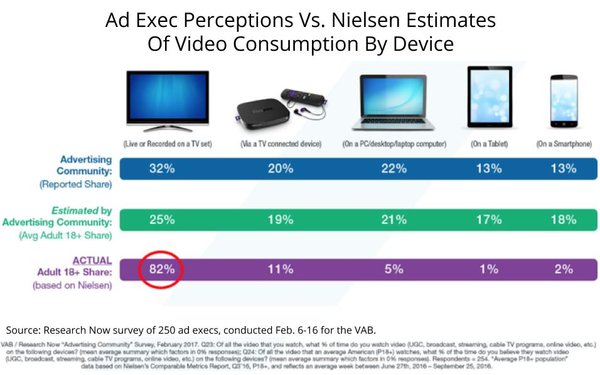Ad Execs Have Distorted View Of Video Across Devices, Overweight Hand-Held
- by Joe Mandese @mp_joemandese, April 25, 2017

Ad executives have a distorted view of how much video they -- and the average American consumer -- spend on various devices ranging from conventional TV sets to hand-held digital devices.
The study, which was commissioned by the Video Advertising Bureau (VAB) and conducted by Research Now, surveyed 250 ad executives (71% agency, 29% marketer) Feb. 6-16, asking them to estimate how much time they perceive themselves and the average American to view video content on various devices. It then compared their responses to Nielsen’s estimates for actual viewing behavior.

The study found that ad execs perceive themselves to watch much more conventional TV, but less video on digital devices than the average American. It also found that their perceptions dramatically overestimated the amount of time spent watching video on digital devices and underestimated the amount of time spent watching conventional TV.
advertisement
advertisement
Overall, ad execs reported watching 32% of their video content on TV, but estimated the average American only watches 25% on TV. According to Nielsen, the average American actually watches 82% of their video programming on television.
On the other end of the digital spectrum, ad execs estimated they watch 13% of their video content on their smartphone, but that the average American now watches 18% of their video on their smartphone. According to Nielsen, the average American watches only 2% of their video content on their smartphone.


Good one, Joe, and I'm glad that you cited the Nielsen findings. If the sample in this study actually represents a true crosssection of ad folks, it shows how ill-informed they are and how the endless barrage of pro-digital propaganda put out in recent years has mislead people who should be as easily taken in.
Make that "shouldn't be as easily taken in" in my last sentance. Sigh!
Joe, 5 years ago you reported on a very similar study by USA Touchpoints. These results show that those in the media/agency business continue to not let facts get in the way of a good story.
Excellent article Joe. Thanks.
From memory Mike Bloxham did a similar study with similar findings when he was at Ball State University.
Confirmation bias, and placing our own usage onto regular consumers is the culprit here
Nice reminder to be data driven in media buying. It's clear that there are major misconceptions regarding the 18+ audience. I found Nielsen's latest breakdown of 18-34 to be interesting. It seems the ad exec's perspective is much closer to what the younger audience is moving toward. When you read the fine print, you notice that mobile viewing doesn't include untagged content and excludes video through apps/web "where video is not the primary focus (e.g. Facebook)". I would argue video is a sizeable focus for FB.
Nielsen-Video-Viewing-18-34-by-Device-in-Q3-Apr2017.png
Updated link: http://www.marketingcharts.com/wp-content/uploads/2017/01/Nielsen-Video-Viewing-18-34-by-Device-in-Q3-Apr2017.png
While there's no doubt we in the ad community can sometimes get a bit disconnected from the behaviors of your typical American--we're exposed to new programming, devices and gadgets first- I do think the results of this survey over index that behavior on Adults...when it's younger audiences- Under the Age of 49 that buyers place media against. The reality is linear TV consumption is down quite substantially for every demo under the age of 50. 18+ takes into account older audiences (50-64 and 65+) that are "propping" up the relative stability of Live TV Viewership...
We all know the trends, and the demos. The fact remains that those in the business are buying media today for advertisers today, but don't seem to have an accurate grasp on media behavior today. We shouldn't make excuses for our lack of knowing "the facts."
Brian, the main loss in total time spent with "traditional TV" is in the very light viewing 18-24 age segment---down about 10% year to year. As you look at each of the older groups, starting with 25-34, you get progressively smaller declines--like 5-6% annually, and even less for the 35-49s. What's really happening is that the primary losers have been the big three broadcast TV networks in primetime, mainly but not exclusively, and certain long established cable channels. However this is not always the case with youth targeted networks such as The CW or with many of their counterparts in syndication or in cable. Even if younger audiences who, as I noted, are comparatively light TV consumers and have always been so, are reducing their traditional TV usage, an advertiser who wishes to target only this segment, can still attain significant, if not universal, reach via TV, though this does not mean that other options should be ignored. I happen to agree, that many of the agency and advertiser types who use TV heavily, have a very dim and outdated understanding of the changing audience dynamics and are maily doing what they have always done---which is not a smart approach---in my opinion.
Hi Brian.
Yes the declines are in the younger cohorts and not the older - we can discuss the magnitude of decline but I think we agree that is fact.
I've been tracking (Australian) TV ratings since the early '90s. When the Internet became searchable (the pull vs. the push theory, everyone (correctly) zoomed in on the 16-24 behaviours. Yep, they were early and strong adopters of the internet and partially at the expense of TV.
All the futurists jumped on board and sounded the death knell of TV as time-spent-viewing was declining.
Well, you know the odd thing some quarter of a century later? These same people are now in the 40-54 bracket and they now watch more TV than they did back in the '90s.
I can only guess as to why, but ethographically it seems to be transitioning from having a job to having a career, from having a boy/girlfriend to having a partner, from renting a place to owning a place. Life just gets in the way sometimes and the idiot-box comes back into play.
Having said that, I think that the overall viewing levels will continue on a long and slow decline as has every medium, and as will the Internet as some stage in the distant future when I am long gone.
John, as I pointed out---and I'm sure it's true in Australia as well----the biggest decline in traditional TV viewing has taken place among those who normally are TV's lightest viewers----the younger, better educated segments. Such people watch half---or less---as much as older consumers in the first place, which is one reason why the reduction of their already low level of TV usage has not had the devestating impact on TV that the digitally enthused theorists have predicated. Ergo, now we see an ongoing campaign to paint well educated "Millennials"---the primary defectors--as the most important consumer segment on this planet ( absurd ). The idea is simple. If Nielsen, refuses to show that all ---or most TV viewing--- is now via digital means---which isn't the case---then try to sell advertisers, who don't seem aware of the facts, on the need to spend huge amounts on digital media to reach the all important "Millennials" who have "abandoned" traditional TV. Fortunately for most advertisers their agencies have some people who do look at the facts and that is why the much hoped for stampede away from TV ad spending to digital has not happened for branding campaigns. Which is not to preclude such from happening in the future---but for now, and the forseeable future, probably not.